Ever ponder if your belongings truly enhance your life or just add to the mess? In today’s fast-paced world, adopting sustainable organizing can turn your space into a peaceful retreat. This article will show you simple yet powerful ways to declutter sustainably. You’ll learn how to create a home that reflects your style and is also eco-friendly. By adopting green organization tips and living more intentionally, you can start building an organized and calm space.
Key Takeaways
- Understanding the concept of sustainable organizing.
- The significance of eco-friendly decluttering practices.
- Simple steps to minimize clutter in your home.
- Tips for creating a peaceful and organized living space.
- Strategies for implementing daily organizing habits.
The Importance of Sustainable Organizing
Adopting sustainable organizing practices significantly boosts personal happiness and environmental health. By embracing eco-friendly habits, you create a living space that is both aesthetically pleasing and values-driven. This approach minimizes waste and encourages conscious living, ensuring you retain only what adds value to your life.
Through sustainable organizing, we combat overconsumption and take on a greater responsibility towards our planet. As we declutter, we craft not just organized areas, but spaces that reflect our dreams of a greener tomorrow. Reducing excess not only alleviates stress but also supports our planet’s well-being.
Your organized environment reflects your lifestyle choices—choosing eco-friendly habits inspires others to do the same. Being mindful of what enters your home contributes to a global shift towards sustainability. The path to sustainable organizing starts with small decisions, yet these choices can profoundly impact our world!
Understanding Clutter: A Personal Reflection
Before we embark on a clutter-free journey, let’s reflect on what clutter means to us. How does our environment affect our mood? Clutter often symbolizes more than just stuff; it can reflect our emotions or unresolved issues.
Reflect on what you truly value versus what just takes up space. This introspection can spark significant life changes. As you explore these feelings, consider how they relate to finding storage solutions that mirror your style.

Recognizing the emotional significance of our belongings is key. Mindfulness in evaluating our possessions fosters a supportive environment. This reflection is the first step toward a clutter-free home and a more satisfying life.
Explore the advantages of a well-organized home office by visiting this valuable resource.
Simple Steps to Begin Your Decluttering Journey
Embarking on a decluttering journey can seem overwhelming, but it’s not insurmountable. By adopting a few straightforward steps, you can embark on a path towards a more organized and eco-friendly home. Start by taking stock of your belongings. Organize them into three piles: keep, donate, and discard. This method aligns with the organizing tips that encourage a thoughtful approach to your possessions.
Adopt the “Farm Chores” approach, dedicating a few minutes daily to tackle small cluttered spots. This method fits perfectly with sustainable practices, turning the task into a daily pleasure, not a daunting chore. By tackling your space in small, manageable chunks, you’ll find the decluttering process both achievable and rewarding!
Eco-Friendly Decluttering and Its Benefits
Engaging in eco-friendly decluttering offers more than a tidy home. By donating items you no longer need, you support a circular economy. This approach reduces waste and benefits others, allowing them to reuse what you discard.
As you start this decluttering journey, remember the environmental benefits. Recycling or donating contributes to a healthier planet. It encourages you to rethink your consumption habits, fostering a responsible mindset. Decluttering becomes rewarding, improving your space while making eco-friendly choices.
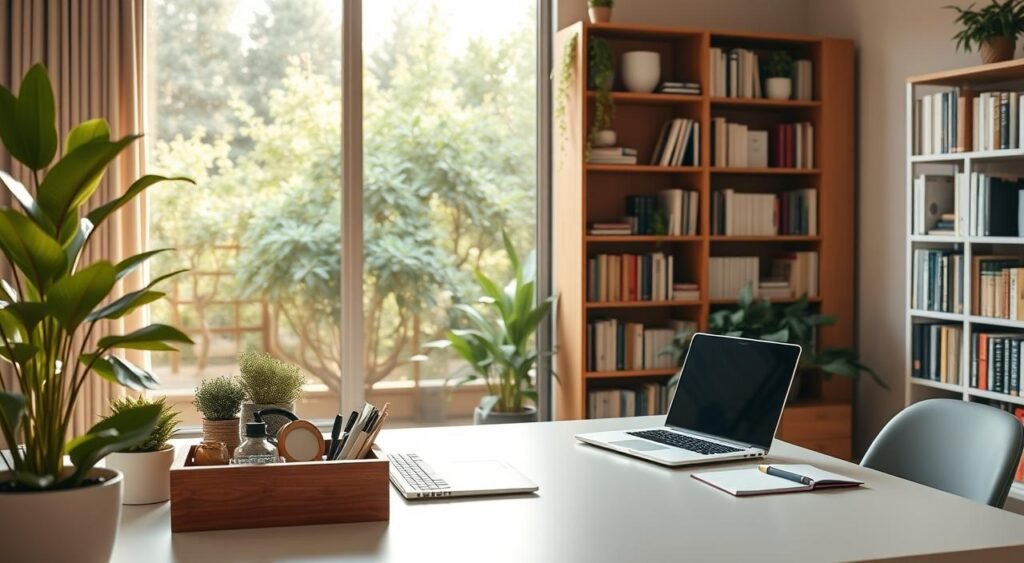
Reflect on the impact of your decluttering actions. You’re not just organizing your space; you’re joining a sustainability movement. Adopting an eco-friendly decluttering lifestyle aligns your actions with a cleaner, greener future. Recognizing the value of sustainable organization empowers you to make choices that benefit both your surroundings and the planet.
Creating Sustainable Storage Solutions
Living in a beautifully organized space doesn’t mean sacrificing your commitment to the planet. Embracing sustainable storage solutions elevates both aesthetics and eco-friendly organization. Start by selecting storage containers crafted from recycled materials, bamboo, or other sustainable resources. These materials not only look great but also minimize environmental impact.
Maximizing space can be a creative endeavor. Consider implementing systems that fit your needs, such as labeled bins, wall hooks, and lazy Susans. These tools promote space optimization while keeping your items accessible and easy to find. The right organization creates harmony in your home, where everything has its place.
As you design your organizing strategy, focus on both functionality and environmental consciousness. Each choice should contribute to a green living organization, promoting an eco-friendly lifestyle. With thoughtful planning and stylish storage options, creating a clutter-free home becomes a joyous and fulfilling journey.
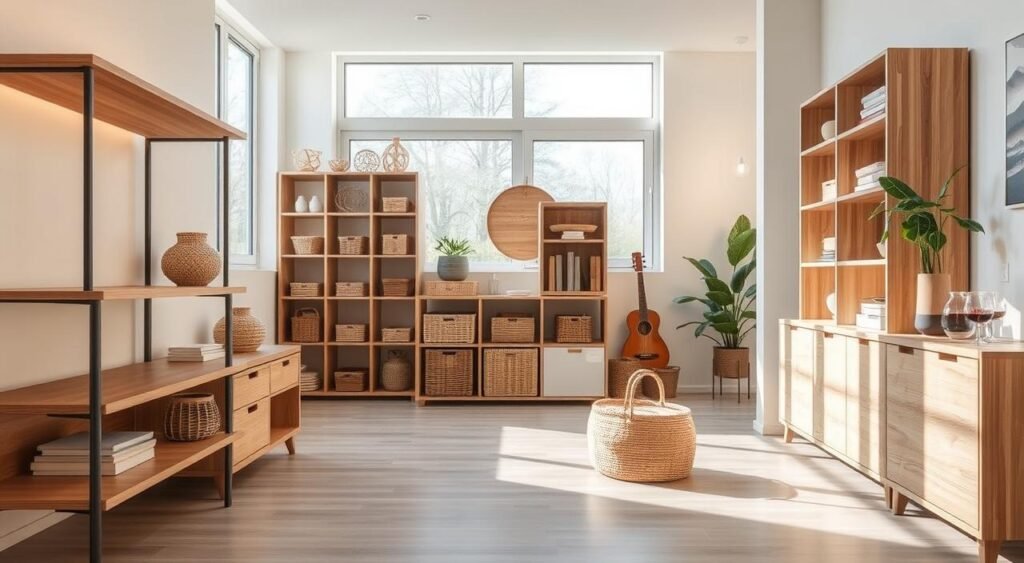
The Role of Mindfulness in Organizing
Mindfulness profoundly impacts sustainable organizing. By incorporating mindfulness into your organizing, you develop a deeper connection with your belongings. This approach makes decisions more intentional, reducing impulsive choices.
Practicing mindfulness helps you align your lifestyle with your aspirations. Reflecting on your values leads to intentional living. It guides you to discard excess and focus on what’s truly important. Regularly assessing your needs ensures a balanced home environment that supports your well-being.
Incorporating simple mindfulness techniques into your routine can be beneficial. Activities like meditation improve focus and create a calm state, making organizing less daunting. Mindful breathing and gratitude journaling instill clarity and purpose in your decisions.
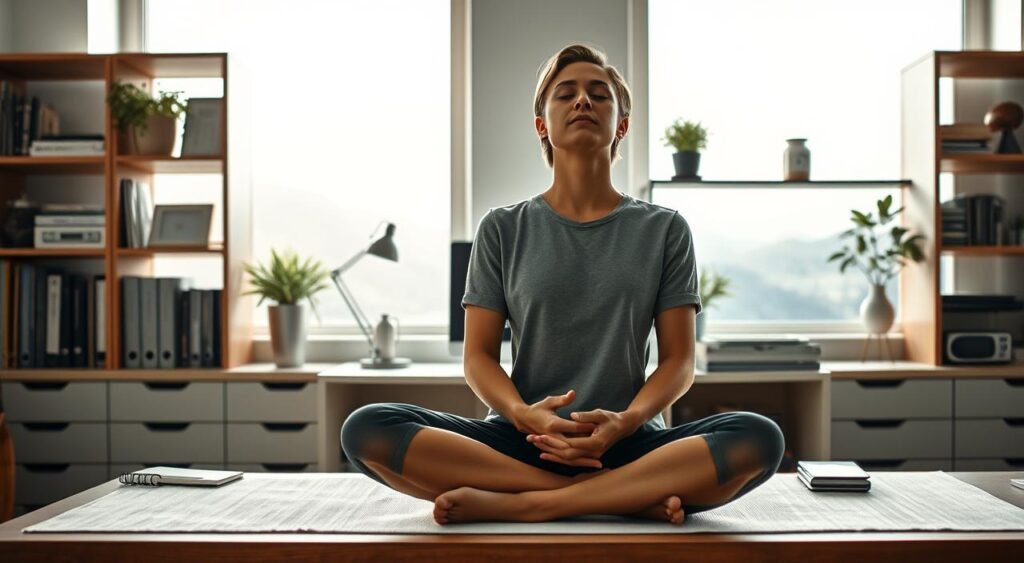
Understanding mindfulness’ role in organizing can lead to a clutter-free, peaceful home. A mindful approach provides a framework for maintaining harmony in daily life. It makes every moment with your belongings more meaningful. For more insights, explore practical mindfulness techniques to enhance your organizing journey.
Establishing Daily Organizing Rituals
Creating daily organizing rituals can turn your home into a peaceful retreat. Just a few minutes each day can keep your space tidy and promote eco-friendly living. By dedicating time in the morning and evening, you can control the clutter that builds up.
Here are some engaging ways to incorporate these rituals into your routine:
- Make your bed every morning – This simple act starts your day with a sense of accomplishment.
- Designate a spot for incoming items – This method can significantly reduce clutter in the long run.
- Sort mail immediately – Keep your surfaces clear by dealing with paperwork on the spot.
- Spend 10 minutes tidying common areas – A brief daily effort can maintain order effortlessly.
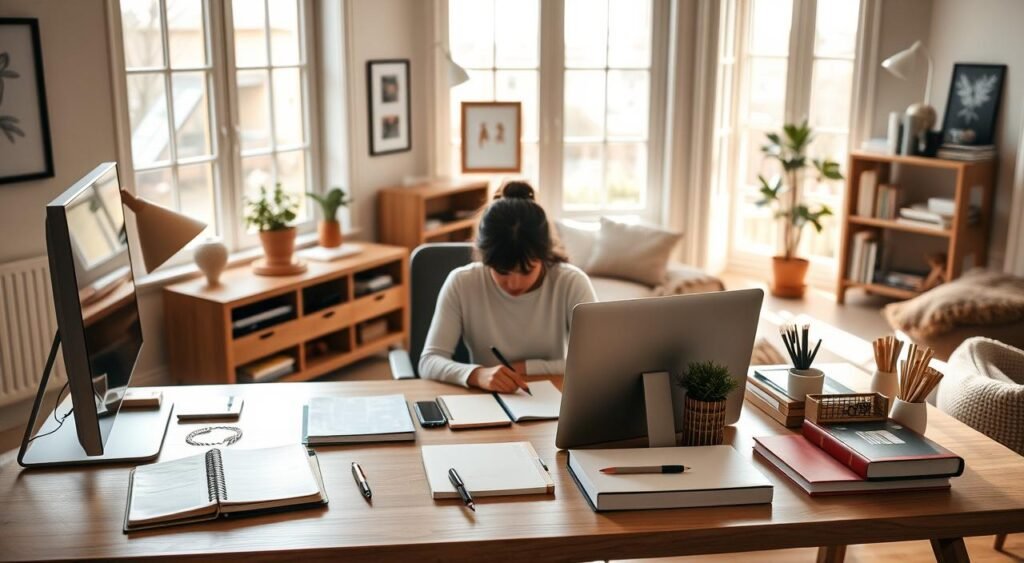
By adding these daily rituals to your life, you adopt a more sustainable way to manage clutter. This habit not only keeps your home organized but also clears your mind. It boosts your overall well-being.
Sustainable Organizing: Practical Tips for Every Room
Every room in your home has unique organizing needs, making area-specific organizing key to achieving harmony and efficiency. Begin in the kitchen by optimizing food storage with containers that keep items fresh. This approach reduces waste, aligning with sustainable practices. Using glass jars instead of plastic enhances both aesthetics and sustainability.
In your living room, consider multifunctional furniture. This maximizes space and promotes a less cluttered environment. Ottomans that serve as storage or coffee tables that hold books and magazines are great examples. These tips make your space feel open and welcoming. Seasonal decor rotations keep your living area fresh and organized.
The bedroom, a personal sanctuary, benefits from regular decluttering. Implementing a system for seasonal clothing swaps maintains efficient storage. Donating items you no longer wear promotes eco-friendly practices and streamlines your wardrobe. Sustainable organizing goes beyond aesthetics; it creates a tranquil space for restful living.
For an insightful look at minimalist home decor as a strategy for sustainable practices, check out this resource.
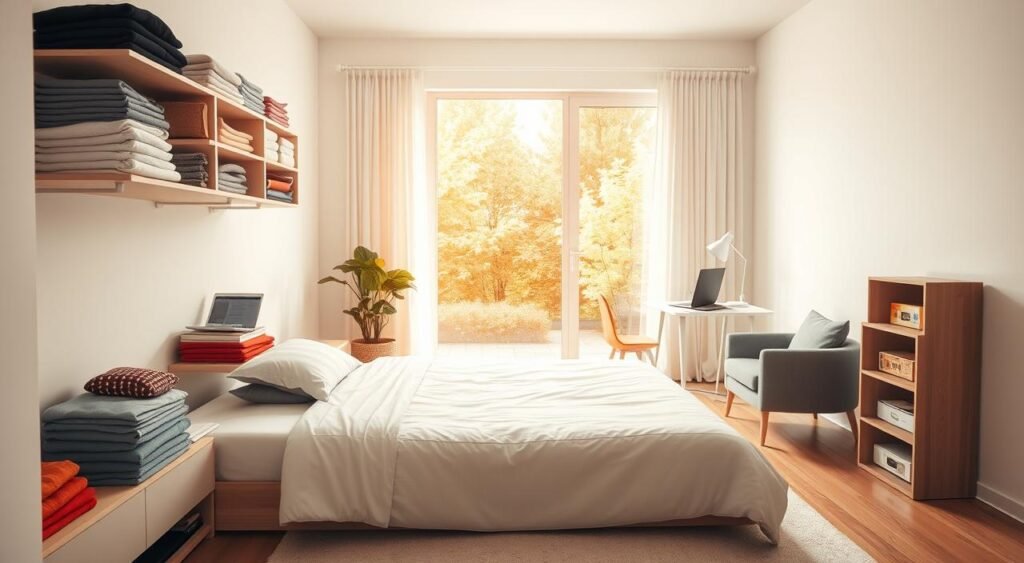
Involving Family: Making Organizing a Team Effort
Engaging your family in organizing can significantly alter your home’s atmosphere. It turns tedious tasks into fun and educational experiences. Family organizing builds a strong team spirit, where everyone works together to create a peaceful space. Teaching children about eco-friendly decluttering equips them with lasting skills.
Begin with family meetings to set decluttering goals. Encourage all, including kids, to help decide what to keep, donate, or throw away. This teamwork not only manages clutter but also teaches each family member about responsibility.
Make organizing fun! Create custom labels for their items, turning it into a creative activity. This approach helps each family member take pride in their space, promoting sustainable habits that protect the environment.
With teamwork leading the way, every family member plays a role in keeping your home tidy. This shared effort not only reduces clutter but also strengthens family bonds. Adopting family organizing promotes an eco-friendly lifestyle, positively impacting your home and the planet.
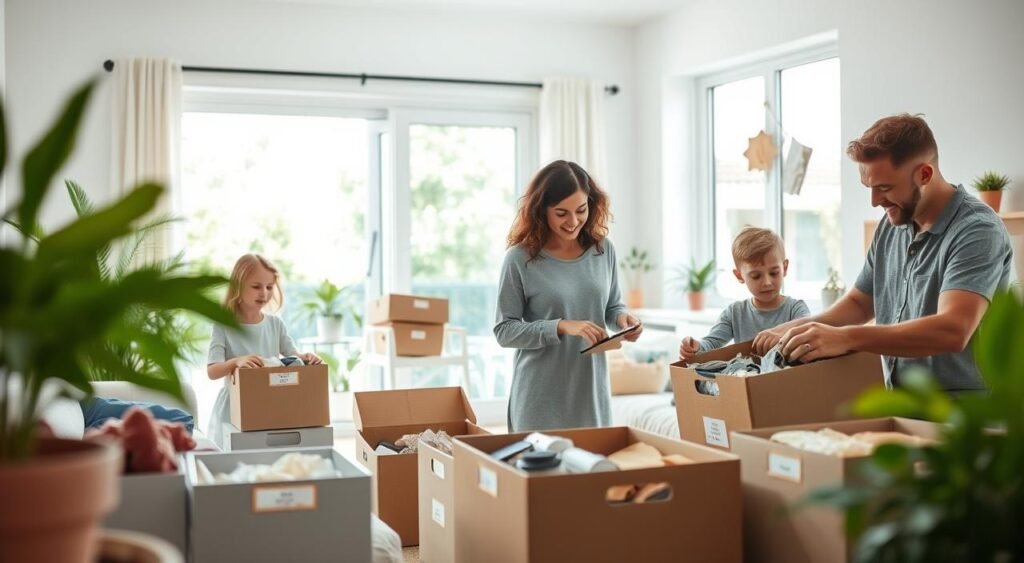
Effective Use of Labels and Signs
Labels are a key organizational tool in your home. Clear and concise labeling tips help everyone find items easily. This practice reduces clutter by saving time searching. Use both functional and fun labels to make organizing engaging. Involving family in this project boosts their interest in keeping things organized.
Effective signage also plays a big role in organizing your home. Signs can guide guests or household members to different areas. They can also remind the family of routines, like tidying up.
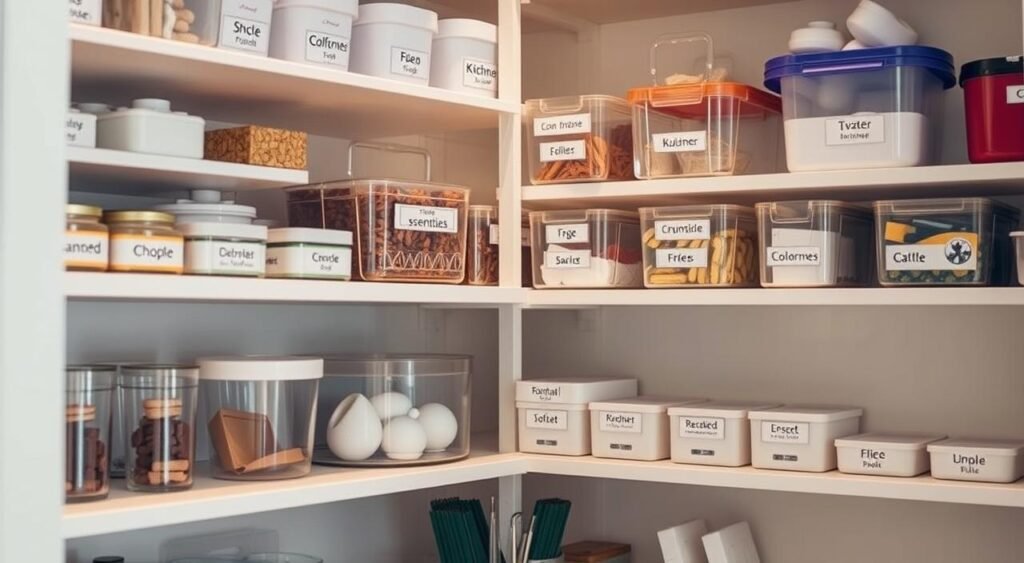
- Choose materials that are durable and easy to read.
- Incorporate colors and graphics to match your home’s decor.
- Make labeling a fun activity by letting children design their own labels.
Integrating labels and signs into your home enhances clarity and aesthetic. This approach organizes items and adds a personal touch. Take the time to implement these labeling tips and create a harmonious living space for everyone to enjoy.
Green Organization Tips for Your Kitchen
The kitchen is often the heart of a home. Effective kitchen organization is key to creating a functional and welcoming space. By adopting eco-friendly tips, you not only boost efficiency but also support sustainable cooking. Begin by categorizing items. Organize similar items together, like everyday dishes and special occasion cookware. This makes it easier to find what you need.
Consider using containers made from sustainable materials like bamboo or recycled plastics. These options offer eco-friendly storage while adding a natural touch to your kitchen. Meal planning is another great strategy. Planning meals ahead can help reduce food waste, making your cooking more sustainable.
To improve your kitchen organization, think about buying pantry staples in bulk. This approach cuts down on packaging waste and can save you money over time. By incorporating these eco-friendly tips into your kitchen organization, you’ll create a more sustainable cooking space.
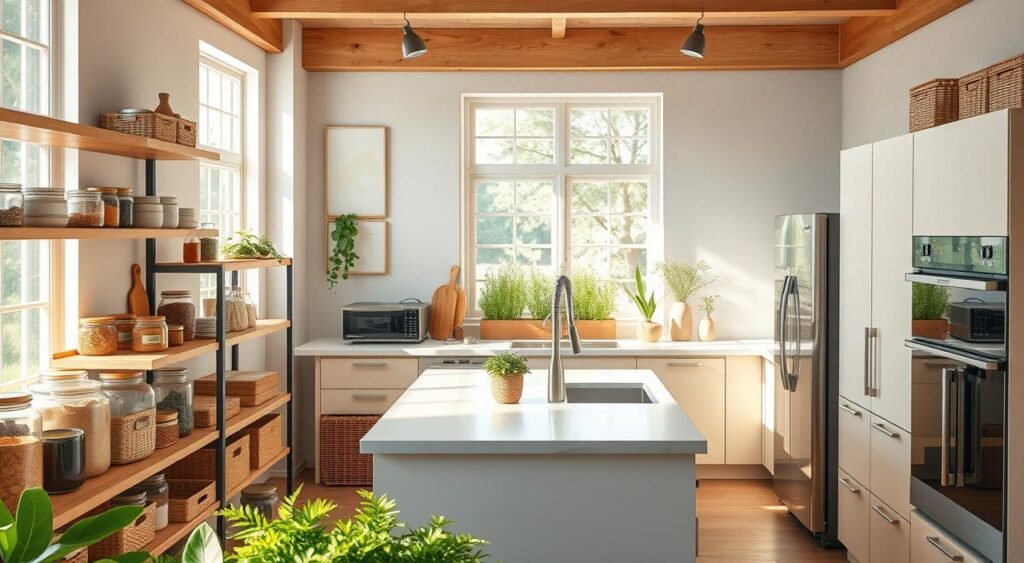
| Eco-Friendly Storage Solutions | Benefits |
|---|---|
| Bamboo Containers | Biodegradable and stylish |
| Glass Jars | Reusable and non-toxic |
| Recycled Plastic Bins | Durable and eco-conscious |
| Compost Bins | Reduces food waste |
By embracing these green organization tips, you lay the groundwork for a sustainable kitchen lifestyle. These practices contribute to a cleaner environment and enhance your cooking experience.
Donating vs. Discarding: The Eco-Friendly Way
Choosing between donating and discarding items is a critical decision for our planet. Donating extends the life of goods and aids those in need. That gently-used sweater or bookshelf could bring joy to someone else. Many charities eagerly accept these contributions, making it easier to practice eco-friendly practices.
Discarding, on the other hand, increases landfill waste, contradicting sustainable living principles. It’s essential to consider the future of your items. If they’re in good condition, reach out to local nonprofits or community resources instead of discarding them.
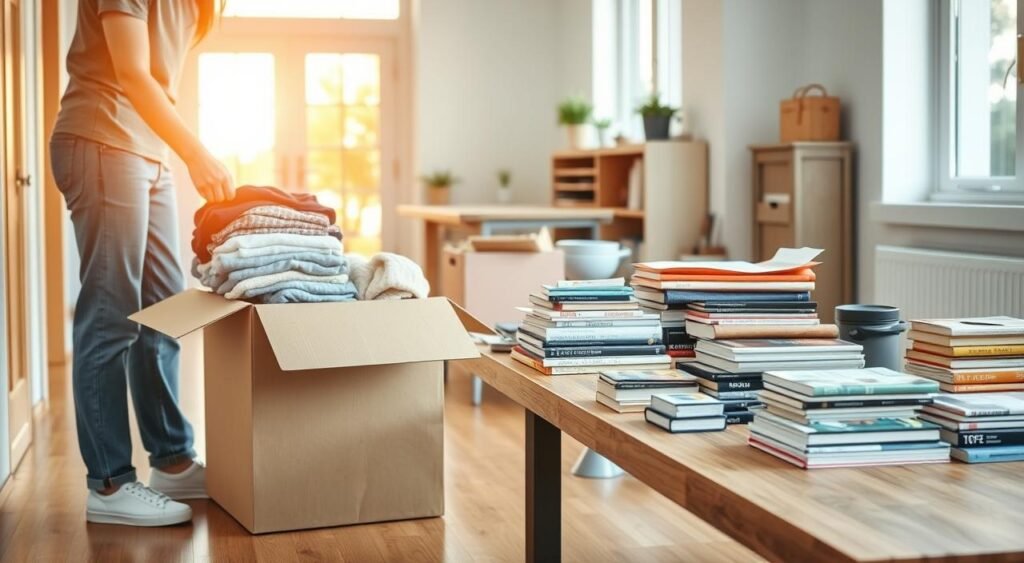
By prioritizing donations, you contribute to a more sustainable and responsible community. It’s a win-win: help others while practicing eco-friendly decluttering. Start today, and make a difference one item at a time!
How to Manage Paperwork and Reduce Clutter
Managing paperwork can feel overwhelming, yet an organized system can make all the difference. I recommend starting with a clear strategy for paperwork organization that meets your needs. Create designated areas in your home for different types of documents, like bills, receipts, and essential papers. By sorting them effectively, you will find it easier to keep track of important files.
Going digital is another fantastic way to reduce clutter. Embrace eco-conscious documentation by scanning important documents and storing them on cloud services. This approach not only clears physical space but also ensures that your information remains accessible and safe from damage.
Consider establishing a routine for handling incoming paperwork. Having a recycling box near your entrance encourages you to discard junk mail immediately. This small step creates an ongoing decluttering habit and helps you maintain an organized environment. Streamlined paperwork organization puts you in control while contributing to a more serene home atmosphere.
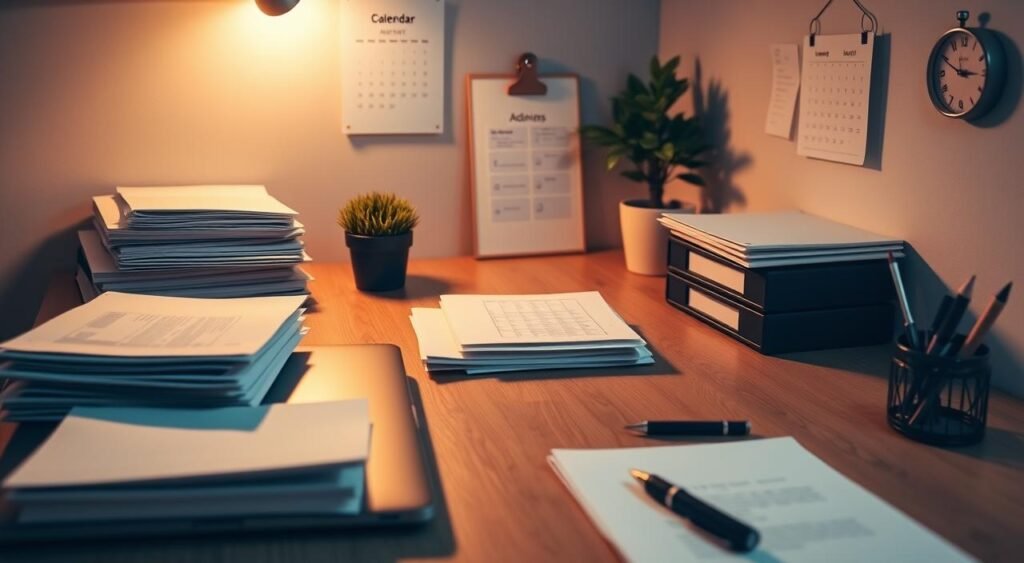
Upcycling: Creative Ways to Repurpose Items
Embracing upcycling opens a world of possibilities for transforming items destined for the landfill into something valuable. You can turn everyday objects into pieces that are both functional and decorative, imbued with personality. Picture transforming old wooden pallets into a chic coffee table or reimagining glass bottles as stunning vases. The realm of upcycling ideas is endless, inviting you to explore.
Exploring sustainable creativity reveals the hidden value in discarded items. A simple tin can can become a hanging planter, while fabric leftovers can be transformed into vibrant wall art. Each item holds a unique story, adding charm to your space. Engaging in these projects not only enhances your home but also brings a sense of fulfillment.
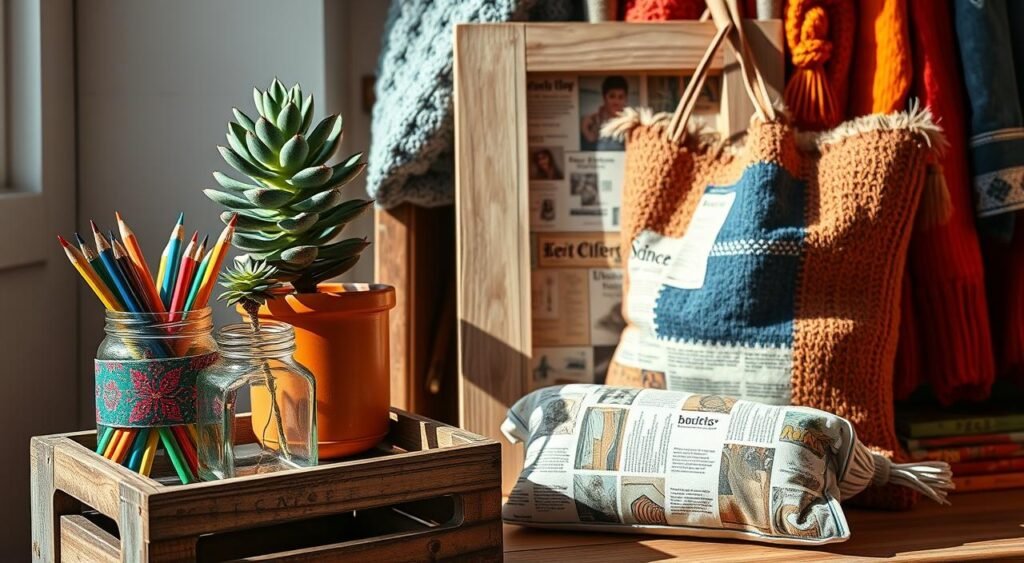
- Turn old shirts into reusable shopping bags.
- Repurpose wine corks into coasters.
- Convert an old ladder into a bookshelf.
- Use tin cans to create desk organizers.
With creativity and the right mindset, repurposing items can become a delightful part of your sustainable living journey. Let your imagination run wild, and witness how discarded items can become precious treasures. It’s all about finding that spark of inspiration to give new life to your home!
Organizing Toys: Strategies for a Kid-Friendly Space
Creating a joyful environment through effective toy organization is key for kid-friendly spaces. Using baskets or bins from natural materials not only controls clutter but also brings eco-consciousness to your home. These containers, when labeled clearly, encourage your children to actively organize their toys.
Engaging kids in sorting can turn it into a fun activity. Consider a “one-in, one-out” rule. This rule manages new toy influx while promoting eco-friendly choices for future gifts. Such practices foster a sustainable culture in their play area.
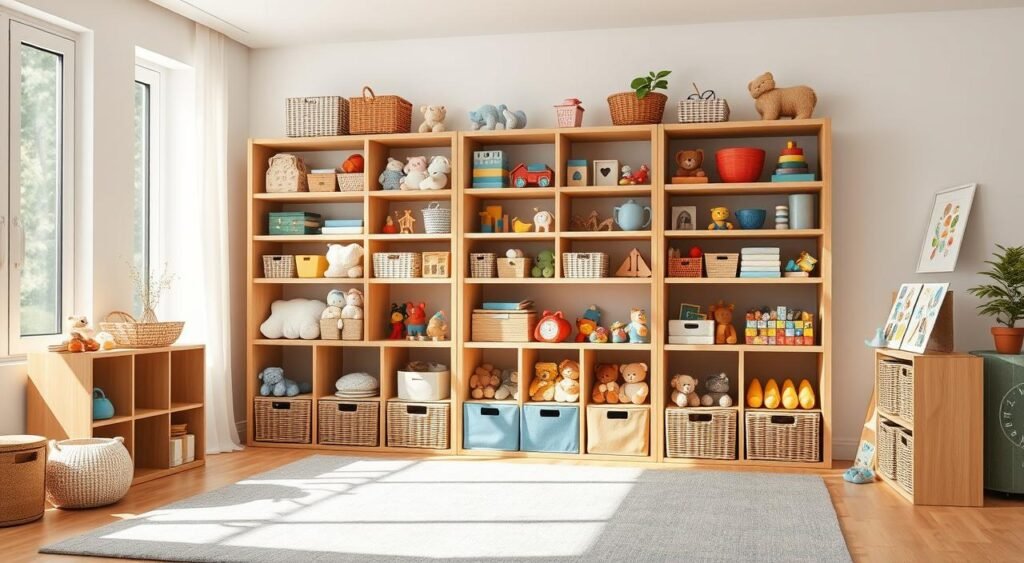
For more ideas on stylish and sustainable organizing, explore various options through affordable home decor products. By adopting these strategies, you can keep a clean, efficient, and welcoming space. This allows your children to thrive and enjoy their playtime.
Maintaining a Clutter-Free Home: Long-Term Strategies
Enjoying a clutter-free home requires a long-term commitment. Developing routines can turn your space into a serene haven, not a chaotic mess. Regular decluttering sessions are key to maintaining this state. Spending just a few minutes each week can significantly improve your home’s atmosphere.
Embracing minimalism is a powerful step. Consider what you truly need and let go of items that don’t serve a purpose. This not only cleans your space but also supports sustainable living. By focusing on quality over quantity, you foster a lifestyle that values what truly matters.
Integrating sustainable practices, like composting and recycling, into your routines is beneficial. Small actions, such as setting up recycling bins, make eco-friendly choices second nature. These habits support your organizational efforts and environmental commitment.
Establish a culture of sustainability in your home. Encourage your family to adopt these habits, highlighting the value of a clutter-free environment. This collective effort can lead to lasting changes, prioritizing intentional living. As you invest in these strategies, your spaces will likely remain clutter-free.
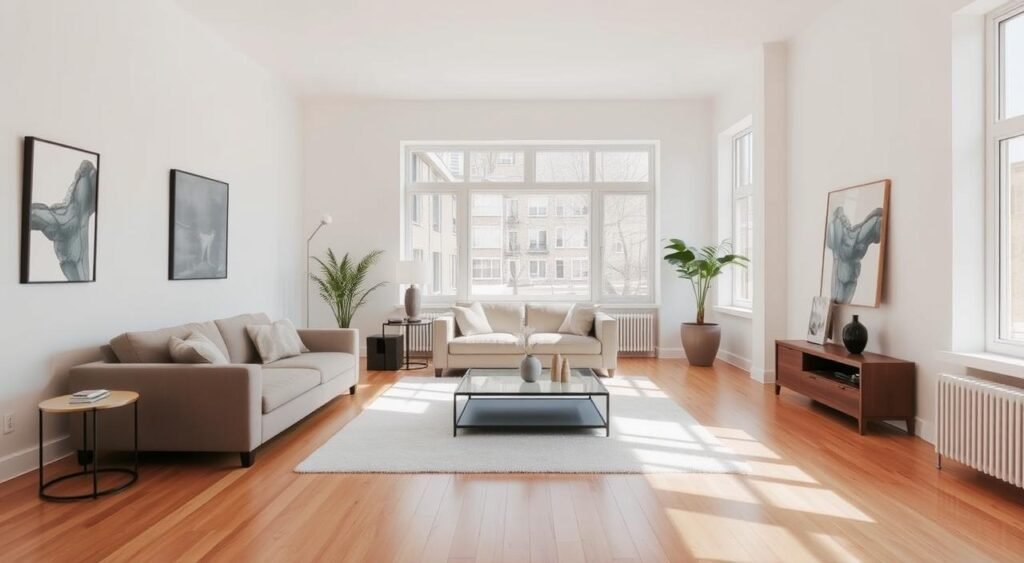
Conclusion
Embarking on the path of sustainable organizing is a deeply rewarding experience. It not only turns your living area into a serene, clutter-free space but also champions eco-friendly living. This approach is vital for our planet’s health. The strategies outlined in this guide empower you to craft a living environment that mirrors your personal style and values.
Every step towards sustainable organizing counts. It’s the daily habits and creative reuse of items that collectively lead to a healthier, happier life. Adopting this perspective enables you to maintain a tranquil home while actively supporting the environment.
Let’s pledge to live with both beauty and responsibility in mind. By doing so, we can create homes that are welcoming and contribute to a greener world. Here’s to your journey towards a more organized and eco-aware existence!
FAQ
What is sustainable organizing?
Sustainable organizing blends eco-friendly habits with organizing methods. It aims to create a space that is both tidy and environmentally friendly.
How can I start eco-friendly decluttering?
Start by sorting your belongings into keep, donate, and discard piles. Think about each item’s purpose. Donating items is often better than throwing them away.
What are some sustainable storage solutions?
Choose storage containers from recycled materials or bamboo. Use labeled bins and wall hooks to organize. These methods support eco-friendly practices.
How does mindfulness relate to organizing?
Mindfulness helps you choose items thoughtfully. It builds a meaningful connection with your belongings. This leads to a clutter-free space.
What daily rituals can help maintain a clutter-free home?
Dedicate time each day to tidy up. Make your bed and sort mail. This prevents clutter from accumulating.
How can I involve my family in sustainable organizing?
Teach your family about decluttering’s importance. Involve them in deciding what to keep or discard. Use fun labels and teamwork to share responsibility.
What are some green organization tips for kitchens?
Organize kitchen items by use. Use eco-friendly containers. Meal planning and bulk purchases reduce waste and packaging.
How can I determine what to donate versus discard?
Think about an item’s future usefulness. If it can help others, donate it. This reduces landfill waste and supports sustainable living.
What strategies can help manage paperwork and reduce clutter?
Organize important documents effectively. Use digital storage. Have a recycling box for junk mail. These steps simplify decluttering.
How can upcycling contribute to sustainable organizing?
Upcycling transforms unwanted items into something new. It reduces waste and promotes mindful organization in your home.
What are some effective ways to organize toys sustainably?
Use natural material baskets for toy storage. Involve kids in sorting. Implement a “one-in, one-out” rule for new toys to control clutter.
How can I maintain a clutter-free home in the long term?
Regularly declutter and adopt minimalism. Incorporate sustainable practices like composting and recycling into your daily life. These steps ensure lasting results.
